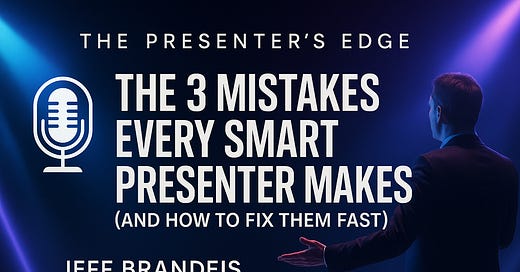🧠 The Presenter's Edge
By Jeff Brandeis | EngagingWebinars.com
You’ve done the work. You’ve got the insights, the experience, and the audience. So why does your virtual presentation still fall flat?
Here’s the surprising truth: smart professionals often struggle with presentations—not because they don’t know their stuff, but because they’re using outdated or ineffective delivery methods. These mistakes aren’t about intelligence or talent. They’re about strategy—and the good news is, they’re fixable.
Let’s break down the top 3 mistakes I see even experienced presenters make, and how to fix each one fast.
❌ Mistake #1: Talking to the audience instead of with them
The Problem:
Most webinars sound like lectures. It’s one person, one screen, and a lot of talking. Even with the best intentions, this becomes a passive experience for the audience—and passive audiences don’t convert.
When there’s no real interaction, attention drifts. People check email. They leave early. And when you finally make your offer, only a fraction are still with you.
The Fix:
Treat your presentation like a two-way street. Build in checkpoints for interaction every 3–5 minutes. It can be as simple as:
“Quick yes or no in the chat—has this happened to you?”
“Drop a 1 if you agree, a 2 if you’re still deciding.”
“What’s one word you’d use to describe your biggest challenge right now?”
This does two things: it increases engagement and gives you real-time feedback on where your audience is at. Suddenly, it’s not a speech—it’s a dialogue.
If you’re on Zoom, use reactions and polls. If you’re using OBS or StreamDeck, you can even bring audience responses on-screen (something we help our clients install to skyrocket engagement).
When the audience feels heard, they’re more likely to stick around—and take action.
❌ Mistake #2: Overloading Your Slides
The Problem:
We’ve all seen it: slides jammed with bullet points, charts, and paragraphs of text. It’s what I call “slide stuffing,” and it’s a surefire way to lose your audience’s attention.
When people are reading your slide, they’re not listening to you. Their brain has to choose one input. Guess who loses?
The Fix:
Think of your slides as visual anchors, not teleprompters. Each slide should carry one clear message or idea—no more. Use images, big text, or diagrams to support your narrative, not compete with it.
Here’s a simple formula I give my clients:
Start with a bold headline or question.
Add one visual element that creates intrigue or emotion.
Leave room for your voice to complete the idea.
Want to go from “meh” to “magnetic”? Do a slide detox. Review your deck and cut 30–50% of the words. You’ll be amazed at how much stronger your delivery feels—and how much more your audience retains.
Bonus tip: Add moments of surprise. A slide that says “What happens next might shock you…” instantly pulls attention back in.
❌ Mistake #3: Waiting Too Long to Make Your Offer
The Problem:
Too many presenters hold their offer until the final 3–5 minutes, thinking it’s more polite to “just give value” upfront. But here’s the reality: most attendees don’t make it to the end. And if they don’t hear your offer, they can’t say yes to it.
Even those who stay may feel caught off guard if you shift into sales mode with no warm-up.
The Fix:
Seed your offer early and often. You don’t have to pitch right away—but you should frame the value they’ll get by staying until the end.
Try something like:
“At the end of this session, I’ll show you how my clients are using this exact strategy to double their conversion rates—with less stress and more consistency. So if you want a proven process you can use next week, stick with me.”
You’re not pitching—you’re previewing. That way, when you do make the offer, it feels expected and natural, not sudden or salesy.
Also, reference client stories and outcomes throughout the presentation, not just in your CTA. Normalize results. Build trust. By the time your offer slides in, people are already leaning forward
.
💡 Final Thought
The best presenters aren’t just smart—they’re strategic.
They build interaction.
They simplify visuals.
They guide the audience toward action from the start.
The good news? You don’t need a complete presentation overhaul. You just need to install a few powerful upgrades.
And that’s what I help presenters do every day—with tools, training, and turnkey setups that make audience engagement simple and scalable.
👉 Want help making your next webinar your best one yet? Let’s chat: www.speakwithjeff.com
Let’s elevate your delivery, together.
Until next time,
Jeff Brandeis
Webinar Conversion Coach
www.engagingwebinars.com




